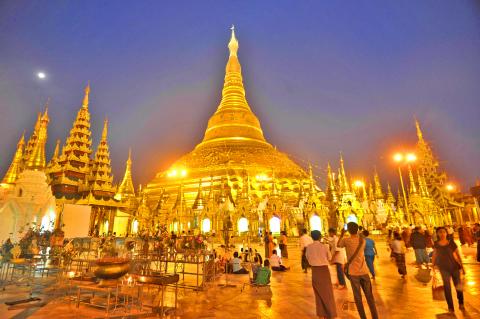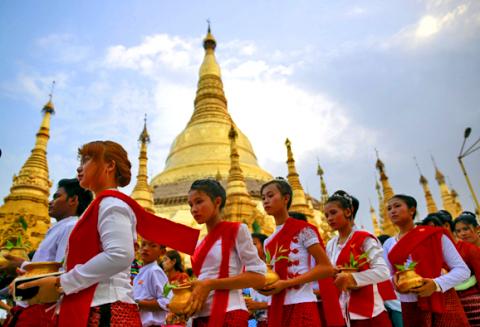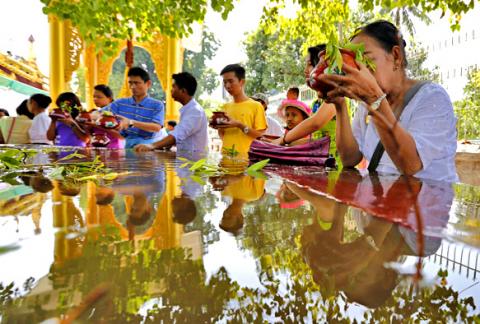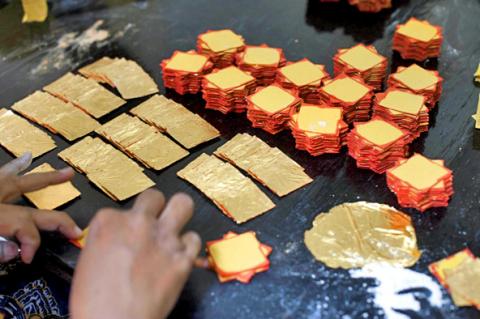As he smooths a gold plaque on the glistening flank of Myanmar’s most prestigious Buddhist pagoda, a merchant pays his ancestors the highest honor — and contributes to a bumper year of donations to re-gild the sacred site.
The Shwedagon Pagoda, which rises in a stately conical tower above downtown Yangon, has been at the heart of Buddhism in Myanmar for hundreds of years, as well as providing a luminous arena for political resistance in the former junta-run nation’s more recent turbulent history. Authorities managing the monument are now cladding the structure with a fresh layer of gold — a five-yearly exercise to replace the older, weather-worn coating.
“This round of donations have come at the right time for me. So I am donating to make merit,” Phone Myint Thwin, 40, told AFP, delighted to finally be able to honor his late grandparents with a gold plaque.

Photo: AFP/ Soe Than Win
Officials had expected to match their 2010 donations of 9,000 gold plates to clad the stupa, but a surge of enthusiasm from Buddhist faithful means they now have 16,000 plates — a gold glut that will enable more of the structure to be gilded.
“People are delighted to witness their own donations on the body of the pagoda. Then they want to donate again because they can make the offering themselves,” said Tun Aung Wai, deputy officer of Shwedagon Authority Office.
MAKING MERIT

Photo: Reuters/ Soe Zeya Tun
At US$600 each, the plates are a big expense in a country where World Bank figures put the per capita gross domestic product at US$1,105.
Financial prosperity is still a dream for many in the impoverished country. But Myanmar’s small-yet-growing middle classes are gradually getting richer, as the economy opens up after years of atrophy under military rule.
The Asian Development Bank has predicted Myanmar’s economy will grow 8.3 percent in this year’s fiscal year, from 7.7 percent in the 12 months to March. But inflation is also on the march — predicted at 8.4 percent this year — partially due to expected wage rises.

Photo: EPA/ Lynn Bo Bo
In a report last year, research group Euromonitor said consumer product sales boomed in Myanmar over the five-year period to 2013, with middle class consumers helping to boost demand for non-essential luxuries like home and beauty care products.
For devout Buddhists it is also essential to donate to pagodas — as well as monasteries and charitable causes — to make “merit,” a sort of credit for pious living.
This practice helped the Buddhist-majority nation to be named the joint most generous nation, with the US, by Charities Aid Foundation in last year’s World Giving Index.

Photo: AFP/ Ye Aung Thu
‘WINKING WONDER’
Shwedagon, which according to legend is over 2,000 years old, is particularly sacred because it is believed to house several strands of hair from the Gautama, whose teachings form the basis of Buddhism, and relics from three previous Buddhas.
The Shwedagon is arguably Myanmar’s most recognizable building, its peak soaring above swirling eddies of barefoot devotees who crowd the pagoda’s terrace from dawn to dusk, alongside the burgeoning ranks of tourists.
It has long captured the imaginations of visitors from author Rudyard Kipling — who called it a “beautiful winking wonder” after a visit in the late 19th century — to US President Barack Obama in 2012.
It was the site of opposition leader Aung San Suu Kyi’s first major political speech as student-led protests against the then military regime swept the country in 1988 — and also at the center of the 2007 monk demonstrations that ended in bloodshed.
GOING FOR GOLD
Gold itself has long had a crucial role in Myanmar.
During the colonial era Burmese women wore almost all of their wealth in the form of jewelery made of gems and gold. After independence, gold became even more integral as the junta’s socialist policies eviscerated the economy, leaving the population suspicious of government banks.
Even the word for gold in the Myanmar language, “Shwe,” is a hugely popular girls’ name.
In the jumbled workshops of the central city of Mandalay, craftsmen hammer gold into slivers for devotees to paper Buddha statues at temples. They are considered some of the finest gold artisans in the country — their craft a testament to the country’s deep connection with the precious metal — but competition for machine-produced gold leaf has raised concerns for their future.
Hla Hla, who has worked in the trade for more than six decades, shrugged off those worries.
“If some like machine-made, they will buy it. But those wanting handmade will buy from us,” she told AFP.

June 23 to June 29 After capturing the walled city of Hsinchu on June 22, 1895, the Japanese hoped to quickly push south and seize control of Taiwan’s entire west coast — but their advance was stalled for more than a month. Not only did local Hakka fighters continue to cause them headaches, resistance forces even attempted to retake the city three times. “We had planned to occupy Anping (Tainan) and Takao (Kaohsiung) as soon as possible, but ever since we took Hsinchu, nearby bandits proclaiming to be ‘righteous people’ (義民) have been destroying train tracks and electrical cables, and gathering in villages

Dr. Y. Tony Yang, Associate Dean of Health Policy and Population Science at George Washington University, argued last week in a piece for the Taipei Times about former president Ma Ying-jeou (馬英九) leading a student delegation to the People’s Republic of China (PRC) that, “The real question is not whether Ma’s visit helps or hurts Taiwan — it is why Taiwan lacks a sophisticated, multi-track approach to one of the most complex geopolitical relationships in the world” (“Ma’s Visit, DPP’s Blind Spot,” June 18, page 8). Yang contends that the Democratic Progressive Party (DPP) has a blind spot: “By treating any

Swooping low over the banks of a Nile River tributary, an aid flight run by retired American military officers released a stream of food-stuffed sacks over a town emptied by fighting in South Sudan, a country wracked by conflict. Last week’s air drop was the latest in a controversial development — private contracting firms led by former US intelligence officers and military veterans delivering aid to some of the world’s deadliest conflict zones, in operations organized with governments that are combatants in the conflicts. The moves are roiling the global aid community, which warns of a more militarized, politicized and profit-seeking trend

This year will go down in the history books. Taiwan faces enormous turmoil and uncertainty in the coming months. Which political parties are in a good position to handle big changes? All of the main parties are beset with challenges. Taking stock, this column examined the Taiwan People’s Party (TPP) (“Huang Kuo-chang’s choking the life out of the TPP,” May 28, page 12), the Democratic Progressive Party (DPP) (“Challenges amid choppy waters for the DPP,” June 14, page 12) and the Chinese Nationalist Party (KMT) (“KMT struggles to seize opportunities as ‘interesting times’ loom,” June 20, page 11). Times like these can